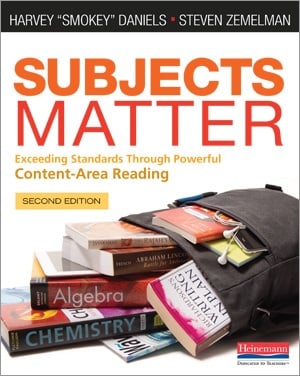Look on a teacher’s professional bookshelf, and there’s a good chance you’ll see “Daniels and Zemelman” on at least one book spine. This week, Smokey (@SmokeyLit) and Steve (@StevenZemelman) added an eighth collaboration to their list of bestselling teacher resources with the Second Edition of Subjects Matter. Today, in part one of this Q&A, they share their thoughts on content-area reading. In part two, they’ll talk about the power of professional collaboration for teachers.
Look on a teacher’s professional bookshelf, and there’s a good chance you’ll see “Daniels and Zemelman” on at least one book spine. This week, Smokey (@SmokeyLit) and Steve (@StevenZemelman) added an eighth collaboration to their list of bestselling teacher resources with the Second Edition of Subjects Matter. Today, in part one of this Q&A, they share their thoughts on content-area reading. In part two, they’ll talk about the power of professional collaboration for teachers.
Question 1: The Common Core is challenging schools to include literacy instruction in every content area. What’s the one thing you’d tell a content-area teacher new to reading instruction?
Smokey: First, be calm! The Common Core isn’t trying to turn us all into reading teachers. But whatever subject we teach, the majority of its knowledge is stored in some kind of text—books, documents, databases, charts, graphs, tables, transcripts, problems, or formulas. The new standards do require us to explicitly show our students how to make sense of that disciplinary text. Simply assigning our kids to “Read chapter 7 for Friday,” no longer counts as teaching kids to read history, or science, or math material. To teach subject-specific reading strategies means we have to get more familiar with what goes on in our own heads when we are reading the content in our field, especially when we are navigating the tough stuff. We have to be able to show kids how a scientist reads differently from a historian or a mathematician. There are habits of mind that characterize the way different disciplines process text, and we can show kids what that looks like through our own example.
Question 2: How can strategies described in Subjects Matter Second Edition help content-area teachers share the passion they have for their subjects?
Steve: One of the most valuable tools for helping students learn how competent readers understand a text is modeling using a think-aloud—in which the teacher reads aloud from interesting material in her subject and pauses at various points to share the thoughts going through her mind. This enables students to concretely see what happens in the mind of a good reader, so it’s not some mysterious, magical process. At the same time, a natural part of the modeling process is to show the pleasure, surprise, and discovery that the teacher-reader is experiencing as he or she reads—“Wow! So that’s why osmosis is so important in cell function. I guess that’s what’s happening in my body right now.” Another way we can demonstrate our involvement with the ideas in our subjects is through the real-world readings we share with our students: news articles about recent controversies or discoveries, portraits of famous personalities in our field, updates that correct or change accepted ideas. For example, a history teacher might run across and have students read an article on new revelations about conditions for minorities during the Great Depression, or one on progressive laws that President Nixon supported. As we explain in our book, supporting reading in our subjects always comes down to what we have students read and how we help them to read it.
Question 3: Smokey, how do Subjects Matter, Second Edition, and Texts and Lessons for Content-Area Reading fit together?
Smokey: You could almost say that Texts and Lessons is the “practice book” for Subjects Matter. You get the big ideas about content-area literacy from this book, where you’ll also see many practical teaching strategies in our Chapter 5. Then, if you like, T&L offers you a whole book of ready-to-teach content-reading lessons, using many of the same strategies. These lessons are written in deep detail and offer specific teaching language that you can try out with your kids. Along with the lessons come 75 adolescent-friendly nonfiction articles which you can copy for classroom use. Nancy Steineke (@nancysteineke) and I selected these “one page wonders” from the New York Times, Rolling Stone, Car and Driver and other high-quality—and high-interest—publications. We are currently tweeting out links to brand-new articles that expand on the topics we introduced in the book (#TextsandLessons), so the resource remains fresh. For any English Language Arts teachers out there, we’ve just released another T&L volume with literature selections—fresh short-short stories and poems. And a third book with mixed genre text sets is in the works.



